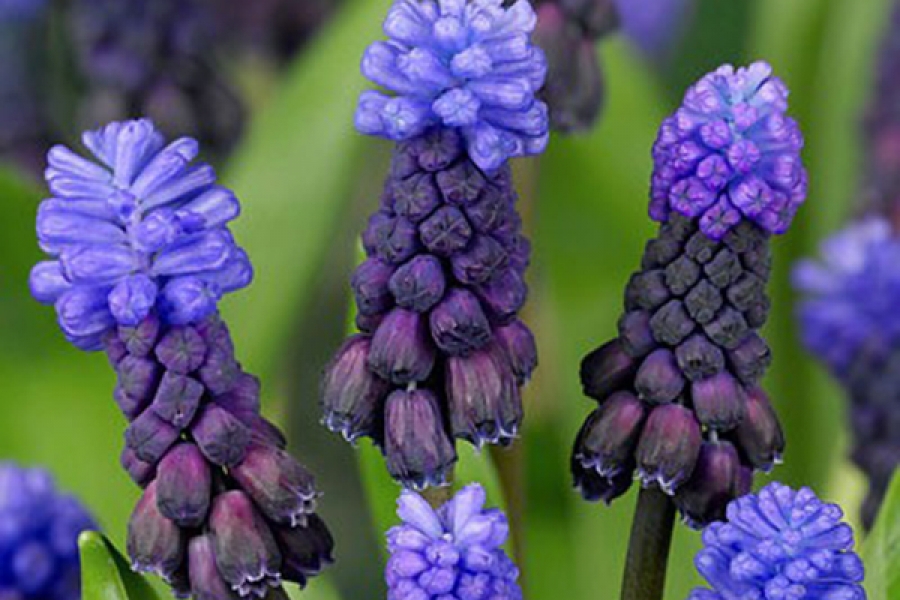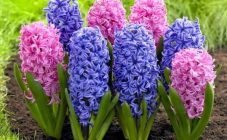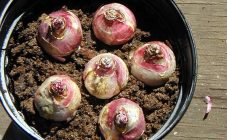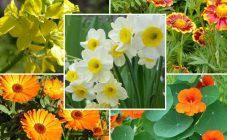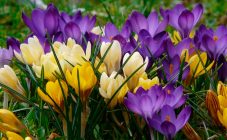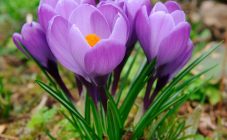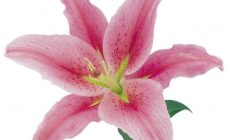Content:
Muscari are beautiful decorative flowers, a real find not only for gardeners, but also for landscape designers. With their elegance and delicacy, they are able to decorate any corner in the garden, flower bed, loggia. With the use of muscarias, you can create unrealistically original and delicate compositions - they go well with other colors. Le Muscari have earned great popularity among flower growers not only for their beauty, but also for their ease of care, their ability to develop well in various conditions.
Origin
The genus Muscari belongs to the Hyacinth family, in some sources it is referred to as Asparagus or Liliaceae. The flowers got their name muscari, thanks to the pleasant refined aroma, reminiscent of nutmeg wine. The first specimens of the plant were brought out at the beginning of the 17th century by the English scientist Phillip Miller. It spread rapidly throughout Europe, Western Asia and North Africa. At the moment, there are about 60 species of muscari - these are wild and cultivated varieties.
Among the people of Muscarica, flowers are known by several names: mouse hyacinth, viper onion, grape hyacinth, due to the similarity with hyacinth and grape bunch. Muscari are called mouse hyacinth because of the small size of the flowers.
In the wild, muscarias are found in the mountains of the Mediterranean, Crimea, Caucasus, Asia, Africa. On the territory of central Russia, 20 species of these amazing flowers are widespread.
Description of the plant
There are several distinctive features by which you can confidently determine that these flowers – this is muscari:
- Small oval bulbs - about 3 cm long and up to 2 cm in diameter;
- The plant is low - up to 30 cm;
- Leaves are rectilinear - 10-15 cm long, in one rosette about 7-10 pieces;
- The peduncle is bare, the inflorescence is racemose up to 8 cm in size;
- The flowers are small, bell-shaped, formed from 6 petals with bent edges;
- Muscari color - various shades of blue, lilac colors: blue, azure, lilac, violet. Plants of white, pink, yellow colors began to appear.
Muscari flowers - small-bulbous perennial. It is an early flowering crop that is classified as an ephemeroid - a profusely flowering but rapidly fading plant. The flowering period lasts about two weeks.
The advantage of culture is good adaptation to various living conditions, endurance, unpretentious care. In addition, the muscari flower reproduces well, one bulb can produce up to 30 daughter bulbs.
Characteristics of species and varieties
Among the variety of species and varieties of muscari culture, it is difficult to determine the most beautiful, since each of them is original and attractive. Several types, the most popular and common:
- Muscari Armenian or Colchis (Muscari armeniacum). The most popular variety. The homeland of this species is southern Transcaucasia and western Turkey. In natural conditions, it grows on the plains. Bulbs up to 3 cm, leaves are straight, slightly narrowed 15-19 cm long. The flower stalk is strong - up to 20 cm, the inflorescence is large, the flowers are voluminous, deep blue, with a pronounced aroma. The upper flowers are sterile, slightly lighter than the others. The flowering period of this species reaches three weeks.
- Muscari Blue Spike.Beautiful terry flowers of sky blue color with a white border along the edge. Inflorescences are large, conical in shape, made up of 150-170 pieces of flowers. Peduncles reach a height of 20 cm. The flowering period lasts two weeks, from the second half of May. A feature of the variety is that it does not form seed pods; in one place without transplanting, the plant develops well for seven years.
- Muscari plumosum or crested (muscari plumosum). An original flower of deep purple color. This species stands out for its unusual form of inflorescence - with a small tuft of light purple color, as well as amazing flowers that resemble the tentacles of an octopus. This plant grows on dry mountain slopes. On home plots, he decorates flower beds and beds.
- Liriope Muscari. The most famous type of culture is Liriope. Habitat - Japan and China. Quite tall flowers - some varieties reach 60 cm. The colors are very diverse, depending on the variety. The most famous of them are Variegata - purple flowers and striped leaves, Evergreen giant - snow-white flowers, Cristmas tree - blue flowers, Gold banded - bright blue flowers, leaves with a gold rim.
- Muscari blue (muscari cueruleum). A rare mountain view. Grows in the alpine belt of the Caucasian ridge. The flowers are bright blue, almost blue.
- Muscari broadleaf (muscari latifolium). A common species in Asia Minor. A feature of the plant is the leaves, wide, like a tulip, high, almost 30 cm, peduncles, of which there may be several. Almost two-thirds of the peduncle is occupied by lush inflorescences with bright flowers, the color of which gradually changes from deep purple to pale blue. Another positive quality of the species is the long flowering period - almost a month.
- Azure muscari or azure hyacinth. Habitat - Turkey. Grows well on mountain slopes, does not tolerate waterlogging. Striking with a beautiful sky blue color with graceful white stripes along the petals.
Features of planting and care
Muscariki are flowers that are undemanding in care and growing conditions. Several basic principles of agricultural technology should be adhered to:
- The choice of planting material. Muscari are propagated by bulbs and seeds. Growing a flower from bulbs is much easier and more efficient. You need to carefully choose them - the bulbs must be healthy and whole. Before planting in open ground, the material should be soaked in a solution of potassium permanganate for disinfection.
- Landing time. Flowers should be planted in late summer - early autumn. Muscari leaves should dry, bulbs should ripen before the onset of cold weather.
- Choosing a landing site. Flowers are able to grow in almost any soil. An exception may be clay soils or areas prone to blocking. In a sunny place, muscari bloom more abundantly and grow faster.
- Landing. Organic fertilizers are introduced into the soil: compost, humus, ash. The soil is dug up, holes are made, 6-9 cm deep at a distance of 15 cm. If the soil is heavy, it often clogs up, sand is added to the holes for drainage. Bulbs are planted, carefully sprinkled, lightly tamped.
- Fertilizer. In the fall, the flowers are fertilized with organic matter; in the spring, you can apply mineral nitrogen-potassium agents. But experienced gardeners say this is not necessary.
- Watering. Humidification is carried out only under conditions of urgent need - with prolonged heat or prolonged absence of rain.
Additional care is the thinning of muscari bushes, removal of dry peduncles and leaves, weeding, regular loosening.
Diseases and pests
Muscari are quite resistant to diseases and pests. But sometimes they can be amazed:
- Mosaic. The flower does not develop, grows poorly. The causative agent is the yellow onion dwarf virus. The disease is not cured. Affected flowers must be removed.
- With mice. You can use garlic to control voles - just plant it between the bulbs.
- Slugs.The prevention is to lower the humidity.
- Aphids. A soapy solution is used.
As a preventive measure, simple measures are used: the bulbs are checked before planting, the affected plants are removed, weeds are weeded.
Muscari is an amazing gift for lovers of flowers and all that is beautiful. They are able to decorate any corner with their airiness, sophistication, tenderness. These flowers combine beautifully with many cultures, bringing zest to interiors, landscaping or compositions.

